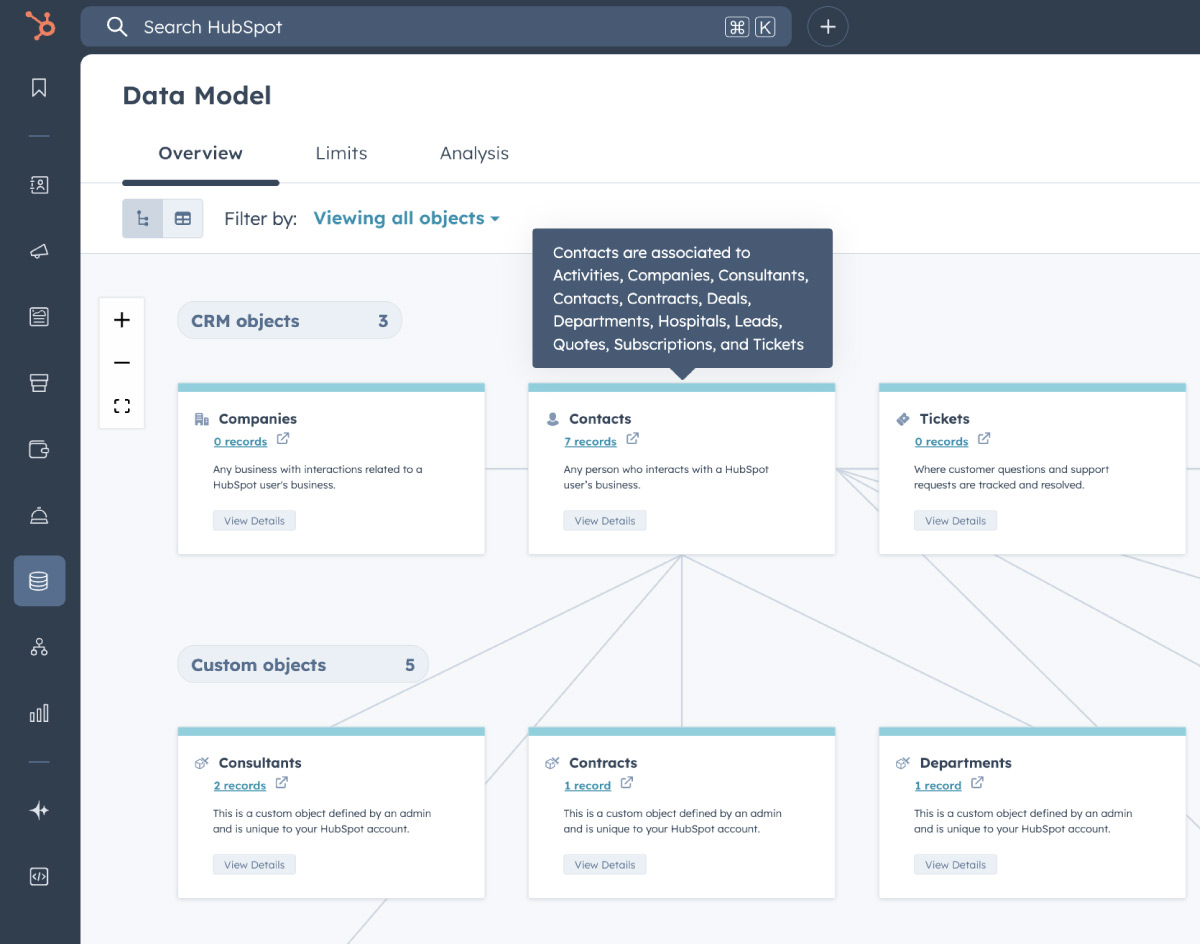SERVICES
CRM Data Modeling
For Businesses who are considering a CRM for the first time, or for more established businesses who are looking to streamline their data structure to support complex business processes, CRM data modeling is an essential step in planning a CRM.

What is a CRM Data Model?
A CRM data model is a plan that details how the data within a A CRM data model is a plan that details how the data within a structured and organized.
In the same way that architects draw up plans for houses, data modelers create plans for data.
A good CRM data model will define how customer information, interactions, and supporting data are stored, associated and accessed. A well executed data model will not only provide a central source of truth for all customer information but it will make accessing that data easy and effective and will underpin the processes that depend on it.

What are the core components of a CRM
There are six key building blocks that data modelers use to create a CRM architecture.
CRM Objects
CRM data is typically stored in Objects. In HubSpot there are four standard Objects, Contact, Companies, Deals and Tickets. In addition to these objects HubSpot offers custom objects which can hold relational data associated with any of the standard objects. An example of a custom object could be Subscriptions for a membership organization or Contracts for a service business.
Relationships
Relationships determine how different CRM objects are connected/associated with one another. For example a Company could have many contacts associated with it and similarly a contact could be associated with many companies. This is called a many to many relationship. Similarly one customer could place many orders this is called a one to many relationship.
Records
Each CRM object holds a series of records. Think of the object as a folder storing files of data (records). CRM records are unique and each one has its own id.
Properties
Properties or fields are part of the CRM record holding key information about the record. For example, a contact record might have properties like name, email, phone number, and address
Data Types
Each property has a specific data type, for example an address property like county could be a dropdown select offering multiple options or first name and last name properties would be singleline text properties.
CRM Cards
A CRM card is a collection of properties grouped together for easy access and view. For example address details on a contact record or key financial properties on a deal record.
Different data models
There are three types of CRM data model which vary from CRM system to CRM system. HubSpot uses an Entity Relationship Model.
Relational model
This is the most common data model which uses related tables to organise data.
Common Data Model
This is a standardized model designed to offer a consistent definition of how data is organised across multiple applications and environments, its used in the Microsoft Power Platform, Dynamics 365, and Azure services
Entity Relationship Model
This is a visual model which shows the associations between objects.
This model can be see in the data model image above.
Why data modeling is important when considering HubSpot
Data modeling is an important first step when considering HubSpot because well structured data is the basis for efficient and easy to use processes.
Without understanding the data that sits at the heart of your CRM it’s very difficult to specify the right technology that should support it.
Help specifying HubSpot with a free CRM discovery session
HubSpot offers four standard CRM objects at Pro level and up to ten custom objects at Enterprise level, but it’s often difficult to determine which package is right for your business.
To help you, we offer a free CRM discovery service.
During a 60 minute discovery session a senior HubSpot CRM specialist will ask a series of deep dive questions to really help you understand your data and how it should be structured should you move to HubSpot.
The output of the session is
- 1x Miro board summarising your data structure
- 1x HubSpot software specification
- 1x HubSpot software quote if required
Book a Demo today for a tour of HubSpot CRM customised specifically for manufacturing companies today.
How we help customers model their data in HubSpot
Our CRM data modeling service is based on a six stage process where we explore your data and processes with you to create a CRM data model ready for CRM implementation.
The output of the process is a Miro Board that visually describes your data model, a sandbox environment that provides a working example of the data model and a property mapping document which details all of the CRM objects, their supporting properties and types.
Our data modelers understand the most effective and efficient way to organise data in HubSpot
Designing a CRM data model
Process Discovery
The first stage in the process is a series of discovery sessions to understand your data, how it is organised and how it supports your business processes.
We set a series of goals for the data model for us to test against later in the process.
CRM Architecture Planning
After the discovery process we create a Miro board detailing your CRM objects, their supporting properties and the relationship between those objects.
Detailed descriptions are added to each object defining its function and the processes it supports.
Property & Object Mapping
With the architecture stage complete, the next step is create a Google Sheet detailing all of the objects contained within the model, their supporting properties, property types, values and relationships. CRM cards and views are also determined at this stage.
If you are having a custom api integration, sync routines and connecting properties are added to the sheet.
Sandbox Configuration
With the initial modeling complete, the next step is to create the model in a sandbox environment. This gives us the opportunity to physically interact with the data model to see if it meets the objectives set out during process discovery.
Test & iterate
Once the Sandbox is complete we test the data model with a small set of data. What we’re looking for at this stage is data that doesn’t fit the model or missing property types.
During this stage the sandbox is adjusted and tweaked until we’re happy that the data is presented in the most effective way.
Deploy
After final testing the data model is ready to deploy.
Typically the next step is CRM implementation where the Miro Board, Property Mapping Document and Sandbox are handed over to an Onboarding Manager for CRM implementation.
Click here to find out more about our CRM implementation service.
How much does it cost?
CRM data modeling can be purchased as a standalone service or more typically as part of your HubSpot Onboarding process.
Data modeling is charged at a flat project rate and includes all of steps detailed above.
COST
£3,500 (ex VAT)
If you would like us to you plan out your data model click on the button below.
"Where is the 6th star?
The Quattro team are absolutely brilliant. Patient, flexible and above all knowledgable. I couldn't recommend them highly enough as your HubSpot partner.
S.Wheen, Global CEO
![]()
The importance of a good CRM Data Model
CRM data modeling is a key step in the effective implementation of a CRM. Without it the CRM can’t display data in the most effective way and this has a knock on effect on the effectiveness of the processes that sit on top of that data.
Get it right, and you’ll have a powerful centralised CRM that tracks every stage of the customers lifecycle, ensuring a seamless experience for the customer and efficient and profitable processes for your business. But to get to this end goal, you need to invest in specialist knowledge and expertise to leverage a CRM to your advantage.

Consistent Data
Consistent data is hugely important in any CRM. A well-defined CRM data model ensures that data is stored and displayed consistently which reduces errors, duplicates and inconsistencies.
Scalability
As your business grows it’s important that your CRM and its data can grow and scale with you, delivering the same efficiencies they did at the outset.
API Integrations
A well defined CRM data model makes integrations with connecting systems like ERPs and Project Management Apps much more straightforward.
Data Accessibility:
A good CRM data model promotes efficiency and productivity as accessible data makes it easy for users to find and access the information they need.
Reporting & Analytics
A good data model facilitates effective reporting and analysis of customer data surfacing valuable insights to empower business decisions.
When you should consider CRM data modeling
Because CRM Data Modeling is such an important step in the implementation of a CRM it should always be the first thing you do.
Think of it like the foundations of a house, it’s impossible to build a stable house without solid foundations, and in the same way it’s very difficult to build efficient and scalable processes without logical and well ordered data. While data modeling is an extra step in the implementation process, it is an investment in getting your CRM right first time.
We’ve seen CRM implementations undertaken without data modeling and unpicking a CRM with unordered data is very difficult and costly. Often it is quicker to throw the CRM away and start again.
Getting it right first time with an effective data model is the spring board for efficient and scalable processes that support a businesses growth and profitability.
Frequently Asked Questions
Detailed below are questions that we often get asked about CRM Data Modeling, but if you have a specific question that is not answered here please don’t hesitate to contact us and a member of the team will provide an answer for you.
How a certified HubSpot partner can elevate your business
HubSpot onboarding solution partners can transform your outcomes. As masters of the platform’s complexities, they offer more than technical expertise. You’ll also get strategic insights that are personalised to fit the unique needs of your organisation.

Customised solutions
Want to boost lead generation? Increase sales conversions? Enhance customer engagement? A HubSpot partner will work to identify your business goals, and then create tailored solutions that deliver on them.
Ongoing optimisation
The digital landscape doesn’t stand still, and neither should your HubSpot setup. Your partner can continuously monitoring and optimise your platform, ensuring it’s scaling in line with your business growth.
Competitive edge
HubSpot onboarding partners have access to all the good stuff. They get exclusive resources and insights directly from HubSpot, which means you benefit from the very latest tools and innovations available.